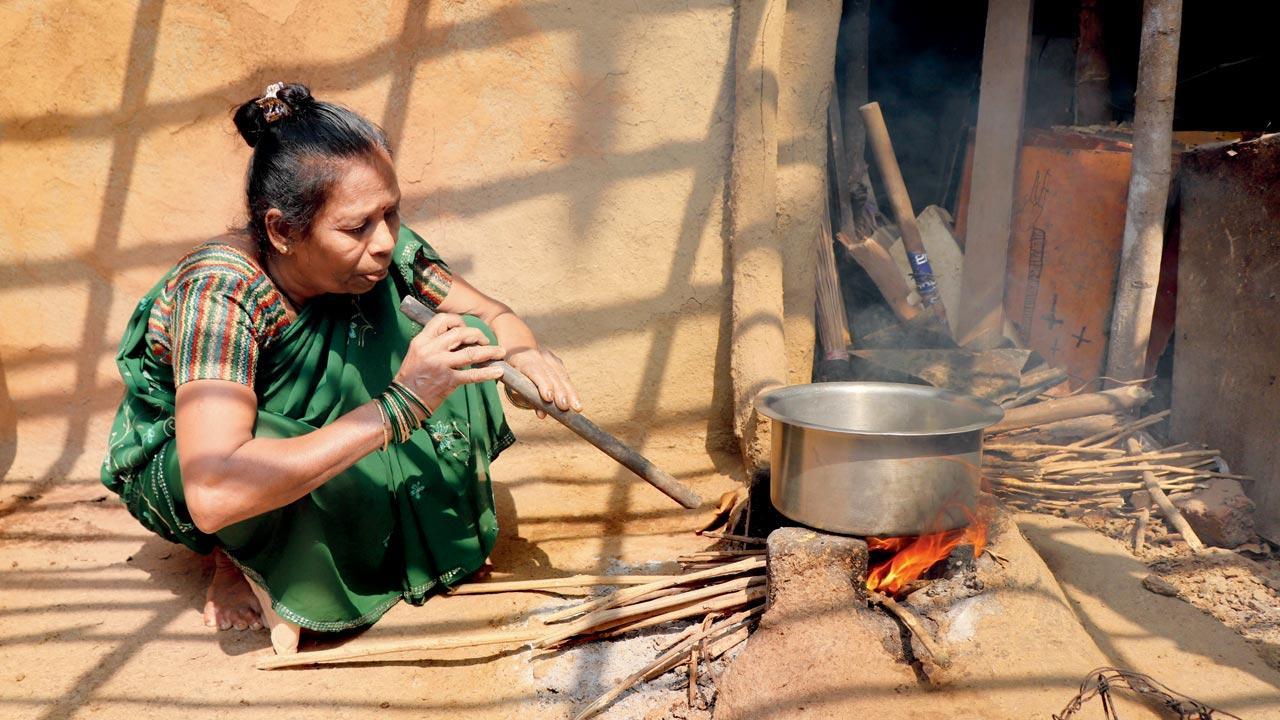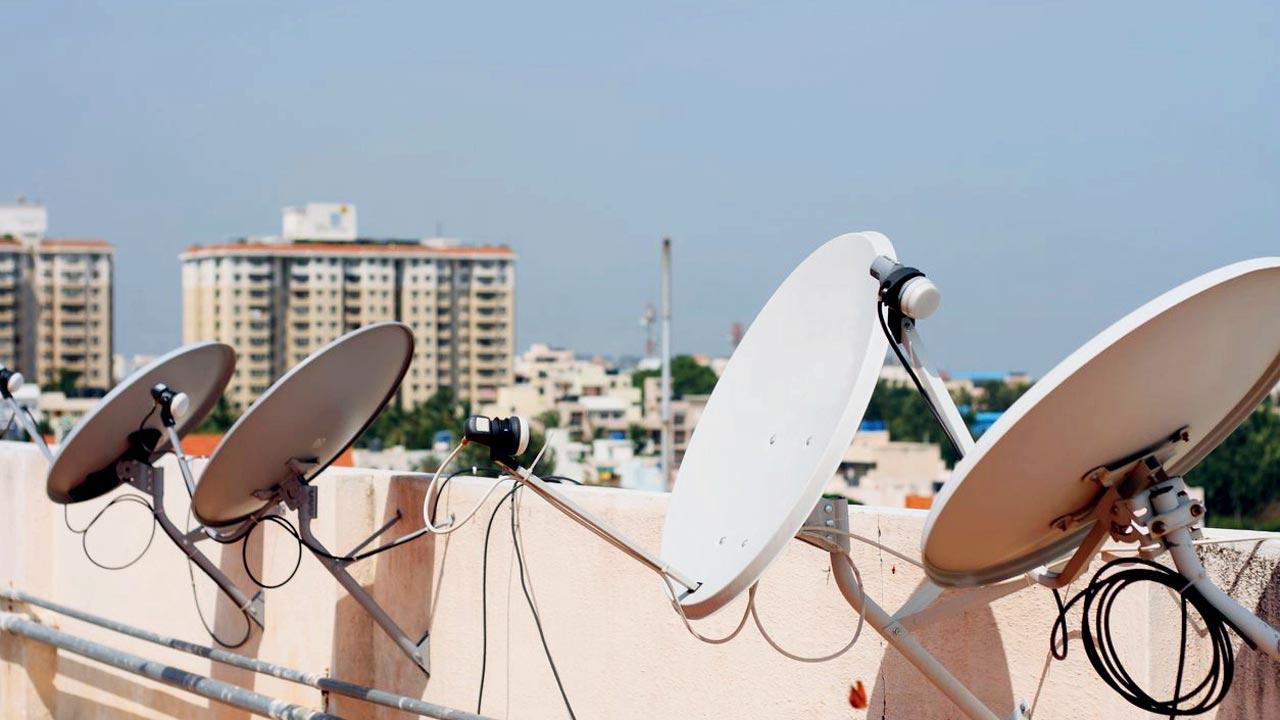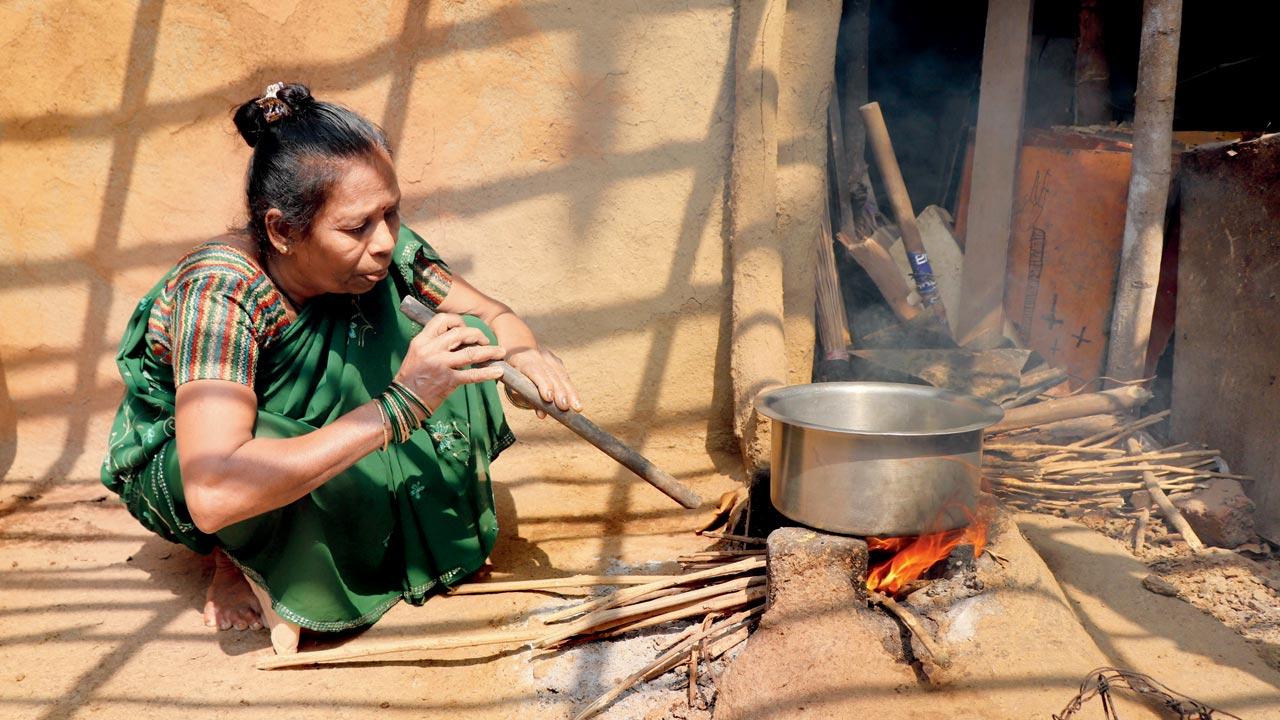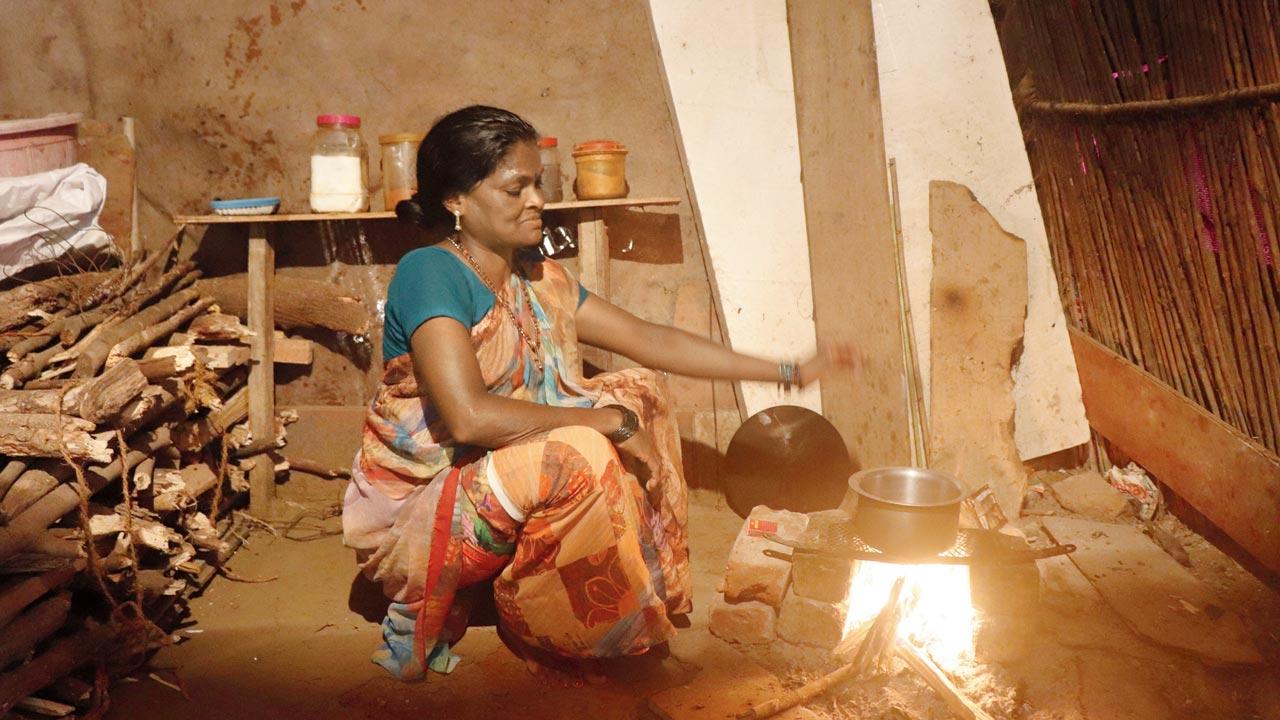In the second part of our series, we explore what data shows about access to information in the digital age

Laxmi Vangad uses a chulha at her Aarey home
As the need for dissemination of information becomes crucial during climate-induced disasters, a study under the Mumbai Climate Action Plan has found that 61.7 per cent of households in the city have a mobile phone, while 20.1 per cent own a computer with access to the internet. But TV rules over the other devices, with 85 per cent of homes having access to it.
ADVERTISEMENT
The study pointed to the extent of socio-economic stability as well as access to information and telecommunication systems that are critical during disasters. As per the study, 36 per cent homes in Mumbai have radios, only 9 per cent have landlines.

The same assessment also revealed that 45.7 per cent of people live in structurally unstable houses with temporary roofing materials, while another 21.4 per cent of households without access to clean cooking fuel.
A BMC official said, “A larger chunk of the population in the city with whom communication is possible before and during such events can help authorities and communities prepare better, efficiently manage evacuation plans and effectively carry out rescue operations. It helps disaster management teams to relay quick messages and alert faster.”
Cooking gas a dream
For decades, Laxmi Vangad, 55, and her husband Laxman, 60, have been using a chulha, a small earthen or brick stove, and are used to the smoke emanating from it. The residents of Keltipada at Aarey Milk Colony are aware that the chulha is a health hazard, but can’t afford LPG or other safer cooking fuel.
 Laxmi Vangad uses a chulha at her Aarey home on Thursday
Laxmi Vangad uses a chulha at her Aarey home on Thursday
“We have been using wood as fuel for generations. Yes, there is too much smoke, at times I keep coughing for hours due to this but we have to live with it. We are poor,” Vangad said.
The Warthes from the locality also face the same problem. “There are many who have now shifted to LPG in our neighbourhood. We too want to do it in the future, depending on our income. For now, we cannot afford it. There are subsidies, but they are not suitable for us. Neither the local corporators nor other elected representatives are concerned about our plights,” said Radha Warthe, 45.
 Aarey resident Radha Varthe had a similar story to share. Pics/Anurag Ahire
Aarey resident Radha Varthe had a similar story to share. Pics/Anurag Ahire
Indu Jethe, 32, another resident from the area, said, “It’s been three years since we shifted from chulha to an LPG gas stove. Gas is a luxury not everyone can afford here. I have gone through all that so I understand their plight. For eight months a year, we used to collect wood to be used as fuel. For four months of the monsoon, there is no dry wood available.”
Indoor air pollution
“India’s path to carbon neutrality by 2070 will almost certainly rely on domestic measures that have already increased energy efficiency and reduced living costs for millions of people. At the same time, it is shocking to learn that 21.4 per cent of Mumbai’s households do not have access to clean cooking fuel. There is an urgent need for the government and the local civic body to intervene,” said Bhagwan Kesbhat, founder, Waatavaran Foundation.
Wood-fired chulhas emit carbon dioxide, methane, and particulate matter, raising indoor pollution and posing serious health hazards.
Kesbhat said, “There is an urgent need to increase climate literacy among citizens, as well as take immediate action to prevent further damage. The government must revamp programmes to ensure that all underserved people have access to clean cooking fuel. Local governments must identify neighbourhoods and households. Ensure that programmes such as the Pradhan Mantri Ujjwala Yojana, which provides LPG connections to households that previously used traditional fuels, reach everyone. Indoor pollution is equally hazardous, threatening the health of newborn babies as well as adults’ lung capacity.”
Indoor air pollution kills an estimated 6 lakh people in India every year, though the data is not gender-segregated.
As per the newly released State of Global Air 2020 report, outdoor and household particulate matter pollution contributed to the deaths of nearly 5 lakh infants during their first month of life in 2020. Almost two-thirds of those deaths were linked to the use of solid fuels for cooking, such as charcoal, wood, and animal dung.
Data from the 2011 Census suggests that firewood is consumed by only 2 per cent of Mumbai’s households. The concentration of PM2.5 in these households is twice that of homes fuelled by kerosene and LPG, as per an analysis conducted by WRI in 2021.
However, the MCAP study says that the data is outdated and may not adequately represent Mumbai’s vulnerability to climate-induced disasters.
Weak homes, big risk
MCAP’s analysis has pointed out that a high percentage of Mumbai residents live in structurally unstable/compromised houses with temporary roofing material. This means these homes won’t protect their occupants from the onslaught of climate-triggered disasters. “The roof is the largest exposed area of a house. As compared with walls and floors, constructing a structurally stable and safe roof built of concrete, burnt brick or machine-made tiles costs more. Hence, houses with roofs made of materials such as thatch, mud, polythene and asbestos are more vulnerable to extreme weather conditions (such as heavy rainfall, strong winds and heatwaves), thereby exposing the residents to a greater risk of climate-induced hazards. Poor housing conditions result in increased risk and vulnerability,” it said.
While 73.7 per cent of the population lives in houses owned by them, about 46 per cent stays in houses with temporary roofing materials which are termed unstable houses by MCAP itself.
Bilal Khan, an activist of Ghar Bachao Ghar Banao Andolan, which is dedicated to the cause of the right to housing, told mid-day that passing the buck amongst the planning authorities is the reason why so many people continue to live in weak houses. “Each land-owning authority has its own rehabilitation plan/policy. Still, they keep delaying procedures to rehabilitate these families. People continue to live in precarious situations. The situation in Malad’s Ambedkar Nagar, where we are working currently, is not good. Every year during the monsoon, residents suffer due to flooding. The process of identifying eligible residents for rehabilitation is completed still the authorities are delaying the process. The planning authorities whether it is BMC or SRA, there is no community involvement,” Khan said.
“Last monsoon, the building adjacent to us collapsed. It was very shocking. We have seen incidents of roof collapses, but buildings fell on some of the houses in our chawl. Since then we too are living in fear, but we have no option. We cannot afford houses elsewhere due to high rentals,” said Rubina Shaikh, a survivor of the building collapse at Malwani’s New Collector Compound in June last year.
A BMC official said, “Most of these unstable houses are unauthorised, illegal or not in BMC’s jurisdiction. For those that are in our jurisdiction, we issue notices, warnings and take action.”
85.3 per cent
Households with a TV
61.7 per cent
Households with cellphone
20.1 per cent
Households with a PC with net
Findings of the study under MCAP
1. Households having radio
Overall Mumbai: 36.2 per cent
Low-rank ward: B 17.5 per cent
Top-rank ward: R/C 55.7 per cent
2. Households with a TV
Overall Mumbai: 85.3 per cent
Low-rank ward: M/E 75.3 per cent
Top-rank ward: R/C 92.4 per cent
3. Households with
PC and internet
Overall Mumbai: 20.1 per cent
Low-rank ward: M/E 7.7 per cent
Top-rank ward: H/W 39.8 per cent
4. Homes with landline
Overall Mumbai: 9.3 per cent
Low-rank ward: M/E 6.2 per cent
Top-rank ward: H/W 14.6 per cent
5. Households having only mobiles
Overall Mumbai: 61.7 per cent
Low-rank ward: D 40.2 per cent
Top-rank ward: L 75.7 per cent
6. Families in owned house
Overall Mumbai: 73.7 per cent
Low-rank ward: C 54.1 per cent
Top-rank ward: R/C 82.7 per cent
7. Population in homes with temporary roofing material
Overall Mumbai: 45.7 per cent
Low-rank ward: S 63.6 per cent
Top-rank ward: C 10.8 per cent
8. Households with access to clean fuel
Overall Mumbai: 78.6 per cent
Low-rank ward: M/E 54.3 per cent
Top-rank ward: R/C 91.3 per cent
 Subscribe today by clicking the link and stay updated with the latest news!" Click here!
Subscribe today by clicking the link and stay updated with the latest news!" Click here!







